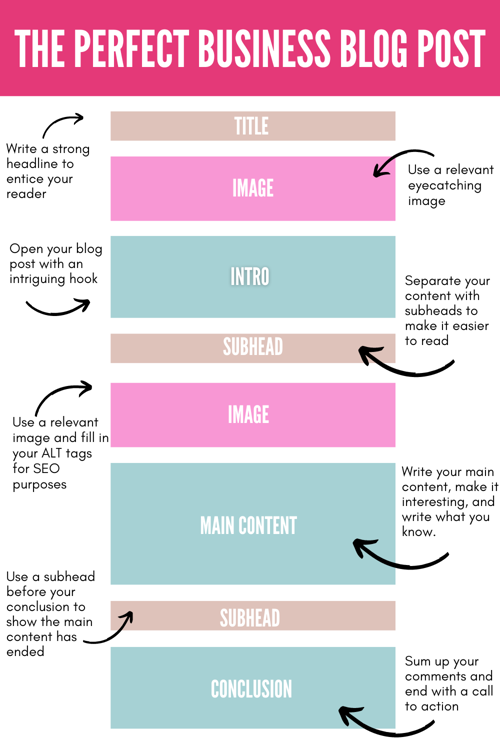How to Write the Perfect Blog Post for Your Business
Ready to write your first blog post but don’t know where to start? If you are a bit confused by some of the terminology used by other bloggers, aren’t sure of the layout of a blog post and don’t know your CTA from your ALT Text then this is the post for you.
Below I go through exactly what needs to go into each of your blog posts and most importantly what element goes where. I’m also including some SEO basics to get you started
Headline
The Headline goes at the top of the page but that doesn’t mean you have to write it first. I regularly write my final headline when I’ve finished my blog post. If you are intimidated by the white space, write a working title confirming what your post is about - for example this blog post was originally titled, “essential elements of a blog post”.
Your headline needs to be engaging and interesting to entice people to read the main article. If you solve a problem, it needs to demonstrate that.
Subheader(s)
Subheaders are generally used to break up the main text and they also help your audience to stay on the page longer. If writing a guide, you might make the questions subheaders, if writing a tutorial a summary of each individual instruction might also be a subheader. I’ve used subheaders in this post to break up each section and talk about the different elements of a blogpost.
Introductory paragraph
Your opening needs to be strong and this is where an intriguing hook can be valuable as it will encourage your visitors to read. In the introductory paragraph, you reel in your readers and confirm why they should read your post in order to keep them reading to the end.
Main content
Now you can start writing your main content and you might find this is the easiest part to write. Blog posts come in all different formats and you can choose the one that’s best for the information you’re presenting. (Check out my previous post with some ideas on the different formats you can use). You can also display your information through bullet points, photos, charts, text, graphics, audio and video.
Links
Dispersed throughout your text should be links. These can be to other pages on your website or to other websites. The more links you have the better, they add authority to your website which helps with your ranking. They also encourage your readers to stay on your website longer.
Images
Images can really help your blog post whether you use your own photos, stock photos (such as those on Pixabay or Pexels) or graphics (either created by you or a graphic designer). You should have at least 1 image per page but be careful about uploading too many as this can slow down the loading time of your webpage. You should also use the ALT tag when you upload the images and write a description of what is in the picture. This will be read by screen readers for those who are visually impaired.
Conclusion
It’s time to finish your blog post so sum up all your best bits, add your final comments and let the post come to a natural and logical end.
Call to Action (CTA)
To finish, ask your readers to take the action you want them to take. It might be to visit a particular webpage, to start a conversation in your comments or to share the post with a friend.
A few notes on SEO
To help with your Google ranking it’s also worth considering a few other elements of your blog post when you are uploading to your CMS. This is not a comprehensive guide to SEO, (I could write an entire blog dedicated to SEO alone) but if you are new it’s something worth considering getting into the habit of taking the following steps when writing your blog post.
Keywords
When doing research, pick a couple of keywords which are the main focus of what you are writing about and mention them a few times in your content. Remember not to go overboard with this as it’s known as keyword stuffing and you can be penalised for it by Google.
Slug
The slug is the web address of your blog post. It’s usually pre-populated based on the title of your blog post but you can normally amend it - make sure it’s not too long and has your focus keywords in.
Meta Description
This is a description of your web page that you write which confirms what your web page is about. It helps search engines to catalogue your content so they know who to send to your website.
What Next?
I hope that helps, the idea of this is that it’s an introduction to writing blog posts and should get you off to a good start. Try not to worry and just write for now. The more you write, the better you’ll get and the better your posts will do.
In the meantime, if you’re stuck for content ideas, why not check out my blog post here which has 20 ideas for blog posts - you’re sure to find some inspiration for your business.
